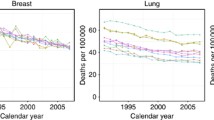Abstract
Objective: To compare the validity of mortality data from available sources in China.
Materials, Methods: Two large-scale surveys have provided accurate national-level rates; the most recent involved deaths occurring in a random 10% sample of the population during 1990–1992. Since then, the only readily available sources are two on-going surveillance systems, which provide annual estimates of mortality – the “Disease Surveillance Points”(DSP) sample survey, and that established by the Center of Health Information and Statistics (CHIS) of the ministry of health, the results of which are published by WHO. They were compared with respect to the representativeness of the populations covered and the rates obtained.
Results: Neither source covers a random sample of the Chinese population, with respect to age group, sex, and urban–rural residence, although the DSP population is the more representative of the national population in this respect. Sex and region (urban/rural) specific age-standardized mortality rates from the CHIS dataset were, however, closer to those from the (1990–1992) national survey, than those calculated from DSP data.
Conclusions: The CHIS data is the preferred source for estimation of national mortality, and study of time trends, but requires appropriate weighting (by age, sex, rural/urban residence). The within-stratum estimates are more stable than those of DSP, because of its larger sample size.
Similar content being viewed by others
References
National Office for Cancer Prevention and Control (NOCPC) of the Chinese Ministry of Health (1979) Investigate for Malignant Tumor Mortality in China. People's Health Publishing House.
Editorial Committee for the Atlas of Cancer Mortality (1979) Atlas Of Cancer Mortality in the People's Republic of China. China Map Press.
Li LD, Lu FZ, Zhang SW, et al. (1996) Analysis of cancer mortality and distribution in China from year 1990 through 1992. An Epidemiologic study. Chin J Oncol, 18(6): 403–407.
Zhou YS, Zhang SW, Li LD (1997) Analysis for death for all and malignant tumors for Chinese Population. Bull Chin Can. 6 (10): 9–11.
Li LD, Lu FZ, Zhang SW, et al. (1997) Analysis of variation trend and short-term detection of Chinese malignant tumor mortality during twenty years. Chin J Oncol 19(1): 3–9.
World Health Organization (1994) World Health Statistics Annual 1993. Geneva: WHO.
World Bank. World Development Report 1993: Investing in Health 1993, Oxford Univ Press.
Yang L, Parkin DM, Li LD, Chen YD (2003) Sources of Information on the Burden of Cancer in China. Asian Pacific J. Cancer Prev. 4: 23–30.
Rao KQ, Chen YD, Chen XZ, et al. (1992) Selection of a national area sample for acquisition of national health information in China. China Health Stat. 9(3): 1-6.
Cancer Mortality Database, Mortality data by country, extracted from the WHO databank: http://www-dep.iarc.fr/dataava/infodata.htm
Ferlay J, Bray F, Pisani P, Parkin DM, Globocan (2000) Cancer Incidence, Mortality and Prevalence Worldwide, Version 1.0. IARC Cancer Base no.5 2001 Lyon: IARC Press.
Murray CJL, Lopez AD (1996) GLOBAL BURDEN OF DISEASE. A comprehensive assessment of mortality and disability from diseases, injuries, and risk factors in 1990 and projected to 2020 Harvard University Press.
National Center of Health Statistics and Information. (1999) Annual Report for National Health Information and Statistics.
Department of Disease Prevention and Control in Ministry of Health, Chinese Academy of Preventive Medicine (1998) Annual Report for Disease Surveillance in China (8). 1997. Beijing Medical University Publishing House, Beijing.
China Statistical yearbook 1998 State Statistical Bureau, People's Republic of China. State Statistical Publishing House, Beijing (1999).
Office of Census in China State Department, Census Department in National Statistical Bureau (1993) State Census Data in year 1990. State Statistical Publishing House, Beijing.
Jensen OM, Parkin DM, Maclennan R, Muir CS, Skeet RG (1991) Cancer Registration Principles and Methods. IARC Scientific Publications No.95, Lyon.
Population Division, United Nations (2002) World Population Ageing 1950-2050. United Nations Publication, New York.
Population Division, United Nations (2001) World Population Prospects, the 2000 reversion volume I: comprehensive tables.United Nations Publication, New York.
Statistics Division, United Nations. Economic and Social Commission for Asia and the Pacific (ESCAP): http://www.unescap.org/stat/statdata/apinfig.htm
Yang GH, Zheng XW, Zeng G, et al. (1992) Selection of DSP Points in Second Stage and their Presentation. Chin J Epi. 13(4): 197–201
National Disease Surveillance Points System (2002): http://www.chinadsps.com/yufang/en_news_list_view.asp
Author information
Authors and Affiliations
Corresponding author
Rights and permissions
About this article
Cite this article
Yang, L., Parkin, D.M., Li, L. et al. A Comparison of the Sources of Cancer Mortality in China. Cancer Causes Control 15, 681–687 (2004). https://doi.org/10.1023/B:CACO.0000036181.37225.91
Issue Date:
DOI: https://doi.org/10.1023/B:CACO.0000036181.37225.91




